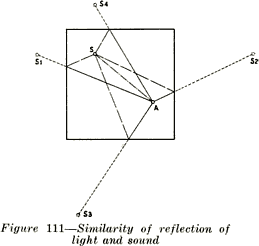The echo effect of a surface may be reduced by changing its shape, by treating it with a sound
absorbing material, or by both. Breaking up smooth surfaces with irregularities, such as coffering,
pilasters, doorways, box tiers, etc., minimizes echo
by dispersing or scattering the sound wave in several different directions. The treatment for echo is
particularly important when using directional loudspeakers since such speakers direct the sound in a
concentrated beam, and oftentimes good volume distribution is sacrificed because the speaker can not
be set to cover all the audience without directing some of the sound toward the echo producing wall.
Like reverberation, echo causes blurred speech and music.
160. Resonance. -The phenomenon of resonance, or the ability to vibrate best at certain frequencies,
may occur in structures or in the air in rooms. Structural resonance usually is not harmful unless the
resonant body is mechanically connected to the source of sound; for example, many musical string
instruments have the vibration of their strings reinforced by a resonant body of wood which is
mechanically connected to the strings.
Resonance in air chambers, such as the rear orchestra section under a balcony, alcoves, foyers, etc.,
does not occur very often unless such chambers are bare of furnishings and have hard reflecting
surfaces.

161. Absorption of Sound. -The blurring and distortion effect on speech and music caused by
reverberation, echo and resonance has already been pointed out. Of these defects, excessive
reverberation is the most common in auditoriums. We now come upon methods for curing these
defects.
Echo and resonance can oftentimes be overcome by changing the shape of the surfaces producing
them. Likewise reverberation can sometimes be minimized by reducing the size of the room. Changing
the shape and size of theatres, however, is not often feasible, particularly after the building has been
constructed. Thus, the most common method of cure is to increase the absorption of the ceiling, walls,
floor, seats, etc.
The amount of sound which a material will absorb depends on its porosity and on its ability to vibrate
as a whole. In general, materials absorb mostly due to their porous nature. Thus plaster, cement, brick,
marble, and wood surfaces, etc., absorb less than 5% of the sound energy which strikes them, while felt-like materials, plush drapes, carpets, heavy upholstered seats, people's clothing, and all the special
sound absorbents made out of mineral rock wool, cane fibres, wood fibres, corn shreds, seaweed,
asbestos, etc., absorb over 25% and a few absorb over 70%.
6
